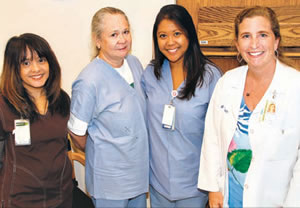Preventing Urinary Incontinence
 Dr. Michele Aspera
Dr. Michele Aspera
Chief of urology at Kaiser Permanente
Where did you receive your schooling and training?
I attended medical school at Cornell University Medical College. I completed both my residency in urology and my fellowship in female urology at the Cleveland Clinic Foundation.
How long have you been practicing?
I began practicing urology in July 2002 at Kaiser Permanente Hawaii.
What causes incontinence?
Incontinence means that there is an inability to prevent the discharge of excretions. As a urologist, I focus on urinary incontinence, which is the involuntary loss of urine. The bladder is a vessel that has only two main functions: store and empty urine. When it fails to store urine properly, incontinence may occur. Urinary incontinence can be caused by increased abdominal pressure, insuppressible bladder urges and chronic bladder over-distention.
Who tends to be at risk for incontinence?
In urology, I see all types of patients with one or more of the four main types of urinary incontinence: 1) stress incontinence, 2) urge incontinence, 3) overflow incontinence and 4) functional incontinence.
Stress incontinence often occurs in our female patients and may develop as a result of weakening pelvic muscles and support (connective tissue connected to the bladder neck and urethra), which may be due in part to age, childbirth or genetics. Urge incontinence refers to the bladder muscle squeezing without much warning, resulting in leakage. Overflow incontinence occurs when the bladder is full and not able to empty, urine will just dribble out. Functional incontinence refers to patients with a normal urinary tract and bladder, but their bodies won’t get them to the toilet on time, whether this is from immobility, dementia or other causes.

Dr. Michele Aspera (far right) with (from left) medical assistant Lani Hangai, nurse Ally Tabali and medical assistant Jen Dill. Rachel Breit photos
I see men and women with urinary incontinence. Up to 10 percent of men may develop urinary incontinence in their lifetime. We primarily see male patients develop urge incontinence from an enlarging prostate or overflow incontinence in the face of urinary retention. Up to one in three women in their lifetime may develop urinary incontinence, mostly seen as stress and/or urge incontinence.
Is it mostly seen in the elderly?
No, urinary incontinence can occur in young patients and older patients, but age is a risk factor for developing urinary incontinence. Other risk factors in women include obesity, diabetes, number of childbirths, urinary tract infections, depression, dementia, hypertension, cigarette smoking, menopause, diuretic use and neurological diseases. Risk factors in men include age, depression, hypertension and benign prostate hyper-plasia.
When women have bladder difficulty during pregnancy and after childbirth, is that considered incontinence?
Yes, if involuntary uri-nary leakage occurs. Often the gravid (pregnant) uterus on the bladder with direct pressure contributes to stress incontinence. This is often best managed with Kegel exercises to strengthen the pelvic floor muscles both during and after pregnancy.
Is there a way to prevent incontinence?
I wish there was. A patient has the best chance of minimizing the symptoms of urinary incontinence by developing good health habits from an early age with a balanced diet, weight management and avoidance of obesity (minimizing risk of diabetes and hypertension), and engaging in routine exercise to include the pelvic floor muscles.
What treatment or help options are available?
First and foremost, I let patients know that not all urinary incontinence is the same and that treatments may differ from person to person. Each patient needs to have clear expectations on improvement of the condition, so I discuss the risk benefit profile for each treatment with my patients.
I begin with less-invasive treatments. I recommend paying attention to the foods and beverages consumed, and following a diet that avoids bladder irritants, such as caffeine. We ask all patients with urinary incontinence to maintain a bladder diary and document the number of voids and volume of urine made in 24 hours, as well as noting the number of leakage episodes during the day. This is invaluable information. We use it in comparison to the severity of urinary incontinence both before and after treatment. We have patients perform pelvic floor physiotherapy for muscle control.
If less-invasive therapies have not reduced the uri-nary incontinence to a manageable amount, then I may opt for medications to treat urge incontinence. This requires a physical exam, a measurement of a post-void residual, and a urinalysis to check for urinary tract infections. These medications are considered bladder muscle relaxers to let a patient’s bladder hold more urine before leakage occurs. For stress incontinence, I will do a bladder function test to see if surgery is more appropriate. I often perform a pubovaginal sling surgery, which provides support to the bladder to reduce the risk of urine leakage from coughing and sneezing.
I recommend that patients seek treatment for bothersome urinary incontinence.
Urinary incontinence is often a problem that can be helped and managed, but I do not use words like “cure.” Our goal in treatment is to take this problem and make things better.



